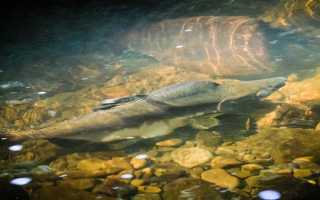Juvenile Salmon

Salmon have supported communities on the coast of British Columbia since time immemorial. However, salmon numbers are dwindling and many questions remain as to the causes. Growing evidence points to juvenile survival in the marine environment as particularly critical, yet little is known about the pressures the young fish endure through this period. Hakai researchers are maximizing their vantage point from the Quadra Island Ecological Observatory, which lies at the intersection between the rearing grounds in the Strait of Georgia and the narrow passages of the Discovery Islands and Johnstone Strait that the salmon need to navigate on their journey north.
Key Questions
- Timing of peak migration for juvenile salmon is highly variable, but so too has been the variability of oceanic conditions since monitoring began in 2015
- Poor feeding conditions in the Discovery Islands and Johnstone Strait make these areas a bottleneck for growth during their northward migration
- The migration path that they choose through the Discovery Islands has bearing on their survival success, though the sources of mortality remain unknown
- Weak oceanographic connections between waters north and south of the Discovery Islands lead to regionally distinct salmon prey
Our Focus
Hakai is bringing together an interdisciplinary research program in partnership with researchers at the University of British Columbia, University of Toronto, Simon Fraser University, the Pacific Salmon Foundation, and Fisheries and Oceans Canada. To understand how the ocean impacts the salmon population as they migrate north, we combine salmon sampling with high frequency oceanographic observations and track the dynamics of the ocean food web using traditional microscopy and the latest genomic technology.

Importance
Shedding light on factors that contribute to juvenile salmon survival or mortality is essential to preserve the species. Up to 90 percent of the juvenile sockeye that head to sea from the Fraser River are thought to travel northward through the Strait of Georgia, Discovery Islands, and Johnstone Strait. This research aims to fill critical gaps in our knowledge of juvenile salmon early marine life that will ultimately contribute to protecting the Fraser River salmon sockeye, and other species, for future generations.
Reports
Select Papers
Hunt, B.P.V., B.T. Johnson, S.C. Godwin, M. Krkosek, E.A. Pakhomov, and L. Rogers. 2018. The Hakai Institute Juvenile Salmon Program: early life history of sockeye, pink and chum salmon in British Columbia, Canada. NPAFC Doc. 1788. 14 pp.
Johnson, B.T., J.C.L. Gan, C.V. Janusson, and B.P.V. Hunt. 2018. Juvenile salmon migration dynamics in the Discovery Islands and Johnstone Strait; 2015-2017. NPAFC Doc. 1790. 10 pp.


